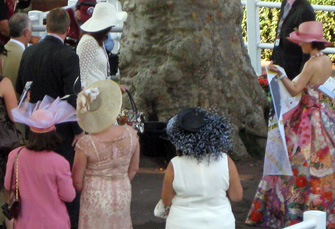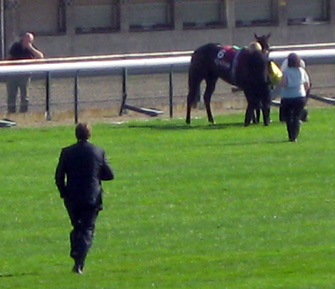 |
|
I didn’t get lucky, but number 9’s grand-sire sure did. |
The horse track is a key fixture of American popular culture, serving as the setting for fiction by writers from Damon Runyon to Charles Bukowski and episodes of TV shows from The Sopranos to Two and a Half Men. Everyone knows that “punters” go to the track whenever the “nags are running,” where they study the “racing form,” consider the odds and the “morning line” and, perhaps with the help of a “hot tip” on a “sure thing” from a “tout,” place bets for their picks to “win,” “place” or “show,” hoping to finish “in the money.” Thing is, though, I have never in my life known anyone who “actually goes” to the races.
Except me, as of earlier this month. For the past 90 years, the first Sunday of October has been the date of the prestigious Prix de l’Arc de Triomphe, France’s equivalent of the Preakness or Belmont Stakes (with the Prix de Diane, held in June at the Chantilly Hippodrome near Paris, being France’s equivalent of the Kentucky Derby). Sponsored by the government of Qatar, this high-stakes race draws entrants from all over Europe and as far away as Japan, and takes place at the Longchamp Hippodrome, a racetrack in the Bois de Boulogne west of Paris.
As with any horse race, betting is a big part of the attraction. At the Arc de Triomphe, you can even start betting before you get to the track: you can buy a ticket from a scalper and play what I call the “Trickster’s Trifecta.” In effect, you’re betting that he’s telling the truth when he says what all the Arc Day scalpers were saying:
1. It’s a real ticket,
2. At €10, it’s cheaper than a legitimate ticket, and
3. Getting one of the latter means a long wait in a long line at the ticket booths.
And, ladies and gentlemen, the official results are in: you’d lose! The scalpers’ wares may have been genuine, but when I got to the gates there were five booths open, each with virtually no line (two or three people at most), selling tickets for €8. And admission was free for women wearing fancy hats, or so I guess – in any case, the guard in my line let the three women ahead of me sashay in ticketless after commenting on their headgear.
Indeed, besides money on equine noses, horse races are closely associated with hats on female heads, and the Arc de Triomphe was no exception:
 |
|
In my crappy photo, they look like unusually well-dressed druids worshipping a tree, but these were a few of the elaborate toppers on parade in the paddock. |
Ladies who didn’t have a hat, left it in the town car or lost it to a gust of wind from a passing thoroughbred could even buy a bonnet at the track:
 |
|
Reflecting the international appeal of the Arc de Triomphe race, the châpeau shop was posting its prices in pounds. |
It would keep the sun out of their eyes, if not the money in their pockets.
When I finally arrived inside the grounds of the hippodrome, it was 2:30 p.m., and I had just enough time to get a bet down on the fourth race of the day, the Prix Jean-Luc Lagardère. (The Prix de l’Arc de Triomphe wasn’t until 4:15.) I should probably point out here that I am not what one would call a degenerate gambler. In fact, I’m not even a vaguely pervy gambler. I enjoy playing centime-ante poker about once every 25 years, and I buy a lottery ticket when the prize is astronomical enough to warrant the astronomically poor odds of winning, but otherwise my “gaming” impulse is essentially nonexistent. Unlike the so-degenerate-he’s-practically-gangrenous gambler I saw wandering the grandstands picking up crumpled bet receipts off the floor on the off-chance that someone had accidentally discarded a paying ticket. But since I wanted to have the whole horse track experience, the Full Feetlebaum, if you will, I decided to put a little cash on the upcoming race.
“Little” is the key word in that last sentence. I knew that I wasn’t going to play the sport of kings for the stakes of sheikhs. I also knew that I didn’t have the expertise to “beat the horses” with anything but a riding crop (and I didn’t have one of those either), so I based my choice on instinct, picking a likely contender from the list and betting €4 to win.
By then it was almost post time, so I went into the grandstands and took up a position where I could more or less see the track through the crowd. The horses lined up in the starting gate and, right at the announced time of 2:55, they took off. The excitement was palpable. To be precise, the excitement of the guy next to me was palpable on my right leg and shoulder. He was gyrating and screaming like a metal singer passing a kidney stone, urging his horse to go faster. This is a common technique for improving one’s chance of winning. To be precise, it’s a common technique for improving one’s chance of winning that doesn’t work: after the finish he tore up his ticket with a snort of disgust and took off toward the bar. My horse didn’t do so well either, moving around the hippodrome like an actual hippo. He wasn’t dead last, but he came in a moribund fifth out of a field of seven.
There was one more race before the main event, so I made another low-roller’s wager, on number 6 to place. This time, my horse didn’t come in last – he didn’t come in at all. I don’t know what happened, but long after all the other horses had finished the race, trotted back to the stables or winner’s circle and tucked into a celebratory or consolatory bag of oats, mine was still standing there in the middle of track, as though he were waiting for a shuttle bus to the finish line:
 |
|
The people who went out to see what was wrong with my horse ran faster than he did. |
My record as a hopeless handicapper thus well established, I then had the task of picking my winner for the Arc de Triomphe. I decided to do more research this time and was aided in this desire by a glossy magazine that the track was handing out, which gave full information on all of the horses in the race, including their past records, who owned them, who trained them, who was riding them and their lineage. And that was how I learned that no fewer than 12 of the 16 entrants in the race were either grand-sired or great-grandsired by the same stallion, a studly steed named Sadler’s Wells.
Sadler’s Wells was a champion racehorse in the UK in the mid-1980s, winning a respectable $663,423 for his owners. But where he really came out a winner was in the breeding business. Yes, Ol’ Sadler was a fillykiller, a hay-fed heartbreaker who sired more than 293 stakes-winning descendants in a run of excellent luck that ranged from 1986 to 2008 and won him the title of Champion Sire in Great Britain and Ireland every year but one from 1990 through 2004. Not bad for a horseface, huh?
Maybe it’s genetic: Sire Wells himself had ancestors titillatingly named Geisha, Polynesian, Royal Charger and (I’m not inventing any of these) Thong, whose hot blood presumably outbalanced that of his great-great-grand-dam, Be Faithful. With a pedigree like that, I had to pick one of his progeny. I settled on number 9, a British-bred, Irish-owned horse named Treasure Beach that had an impressive record. Although this was not saying much, since every horse in the race had an impressive record.
After ponying up a ten, more money than I have ever bet on one thing in my life, I headed back to the grandstands again to watch the race. This was easier said than done. The public seats and standing room had been crowded all day, but for the Arc itself they were packed like a very large can of fancy-hatted sardines. This was what it was like trying to watch the race from the stands:
|
For those who don’t speak French, “Yaaaaaaaaaaagh!!! Wooooooooooh!!!” means, “I believe the horses are now approaching the finish line.” |
Treasure Beach came in third! To last. Whereupon I too unleashed a snort of disgust and took off toward the bar. Where I read up a little more on Sadler’s Wells and learned that, sadly, the old saddlehorn dog died earlier this year at the ripe (for a horse) old age of 30. No doubt with a whinny of content.
Follow C’est Ironique on Facebook
© 2011 Paris Update
FavoriteAn album of David Jaggard’s comic compositions is now available for streaming on Spotify and Apple Music, for purchase (whole or track by track) on iTunes and Amazon, and on every other music downloading service in the known universe, under the title “Totally Unrelated.”
Note to readers: David Jaggard’s e-book Quorum of One: Satire 1998-2011 is available from Amazon as well as iTunes, iBookstore, Nook, Reader Store, Kobo, Copia and many other distributors.
